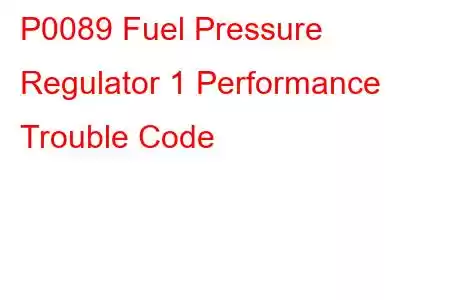P0089 Fuel Pressure Regulator 1 Performance
OBD-II Trouble Code Technical Description
Fuel Pressure Regulator 1 Performance
This diagnostic trouble code (DTC) is a generic OBD-II powertrain code. It is considered generic because it applies to all makes and models of vehicles (1996-newer), although specific repair steps may vary depending on the model.
What does that mean?
The fuel pressure regulator is responsible for maintaining a steady fuel pressure. Some vehicles have a fuel pressure built into the fuel rail assembly. Other vehicles with a returnless fuel supply, the regulator is a part of the fuel pump module inside of the tank.
Returnless fuel systems are computer controlled and the fuel pump output and actual fuel rail pressure is determined by a fuel pressure sensor on the rail that uses the temperature of the fuel to determine the actual pressure. The Powertrain control module or Engine control module (PCM/ECM) has determined that the fuel pressure commanded is not within specifications and will set the DTC P0089.
Note: On vehicles equipped with returnless fuel systems with only a supply line - where the fuel does not return back to the tank, the fuel pressure commanded and actual values may need to be checked using an advanced scan tool capable of monitoring these values. If there are any other codes such as Lean o2 sensors present along with the P0089, the P0089 code should be solved first before proceeding with other codes.
Related fuel pressure regulator engine codes:
P0090 Fuel Pressure Regulator 1 Control Circuit P0091 Fuel Pressure Regulator 1 Control Circuit Low P0092 Fuel Pressure Regulator 1 Control Circuit HighSymptoms
Symptoms of a P0089 DTC may include:
Poor fuel economy Poor acceleration or hesistation Other codes may be present such as lean O2 sensors Check Engine Light illuminated (Malfunction Indicator Lamp)Causes
Potential causes of a P0089 trouble code may include:
Fuel pump output Restricted or pinched fuel lines / clogged fuel filter Faulty regulator Faulty fuel pressure sensor or electrical wiringPossible Solutions
Fuel pressure - Fuel pressure can be checked by using a mechanical gauge attached to the fuel rail. If the fuel pressure is within factory specificaions, there may be a fault with the fuel pressure sensor giving false readings to the PCM/ECM. If a fuel pressure test port is unavailable, the fuel pressure can only be checked using an advanced scan tool or by splicing adapter fittings in between the fuel lines and fuel rail.
Fuel pump - Fuel pump output is determined by the PCM/ECM and may be controlled by an external fuel management computer. The fuel pump may be duty cycle controlled on vehicles with returnless fuel systems. An advanced scan tool may be required to check the output on these type of fuel systems. Test the fuel pump for sufficient power by locating the fuel pump wiring harness. Some vehicles may be inaccessible to easily test the fuel pump wiring connections. Check for battery voltage at the positive terminal of the fuel pump using a digital volt ohm meter set to the volts scale with the positive lead on the power wire and the negative lead on a known good ground with the key in the on or run position. The fuel pump power wire may only be supplied voltage during engine cranking or vehicle running condition. Voltage displayed should be close to actual battery voltage.
If there is insufficient power, suspect the wiring to the fuel pump and trace it back to determine if there is any excessive resistance in the wiring, loose wires or loose/dirty connections. On return style fuel pumps, the ground can be checked using the DVOM set to ohms scale with either lead on the ground wire and the other lead on a good known ground. Resistance should be very low. On returnless style fuel systems, the trig
Read: 57


